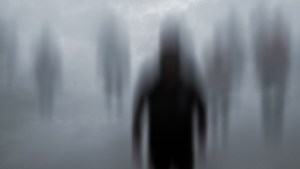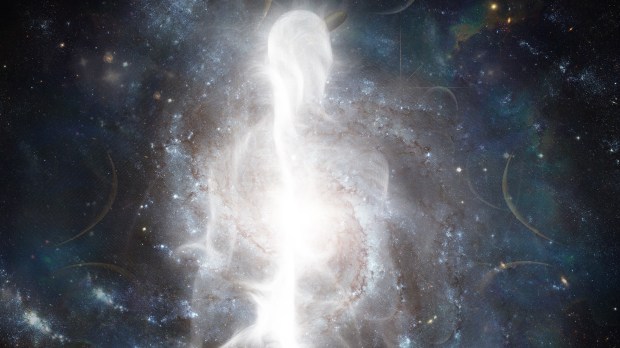As Catholics, we believe that God, the maker of all things visible and invisible, created the world around us with more going on than what lies on the surface. On a normal day, this brings to mind the presence of the divine or saintly intercession. As Halloween approaches, however, this line of the Nicene Creed makes us ponder the most popular of spooky invisible phenomena: ghosts.
Ghost history
The concept of ghosts is nothing new to the world. In fact, even in the biblical days people had a notion that uneasy spirits could return to the corporeal world. In a post for National Catholic Register, Tom McDonald points to instances in the Old and New Testament where ghosts are referenced.
In the Old Testament, in 1 Samuel, the Witch of Endor summons the spirit of Samuel to predict the fate of Saul. In the New Testament, after the Resurrection, the apostles mistake the Risen Christ for a ghost until Jesus invites Thomas to feel the wounds of his corporeal body.
These references are hardly spooky, but they demonstrate that the concept of ghosts is one that humanity has grappled with for thousands of years. In that time, many of the greatest minds of the Church have tried their hand at explaining the phenomenon.
Church Fathers
St. Augustine was one Catholic thinker who broached the topic, and he attributed Saul’s encounter to a demonic entity. According to Catholic.com, St. Augustine considered most ghostly sightings to be angelic visions. It is worth noting, however, that Augustine’s thoughts on the matter were written with the intention to draw the faithful away from pagan practices.
St. Thomas Aquinas, on the other hand, thought that ghosts were a reality. In fact, St. Thomas Aquinas is said to have had several encounters with ghosts in his time. On one occasion he reported being visited by the spirit of a close friend, one he did not even know had passed away yet. St. Thomas Aquinas wrote of ghosts:
“… according to the disposition of divine providence, separated souls sometimes come forth from their abode and appear to men … It is also credible that this may occur sometimes to the damned, and that for man’s instruction and intimidation they be permitted to appear to the living.”
Modern views
The Catholic perspective on ghosts has continued to develop in the centuries since these Doctors of the Church penned their thoughts. In more recent times Catholic theologian and philosophy professor Peter Kreeft has categorized the different types of ghosts. Kreeft posits that there are three different types of ghost:
- “Sad, wispy”: The “sad, wispy” ghost is a purgatorial spirit that suffers until it is released from its remaining earthly business. These ghosts remain behind to learn a lesson from their mistakes made during life.
- “Malicious and deceptive spirits”: These are entities that come “from hell,” and are most often conjured haphazardly during séances or using a ouija board.
- “Bright, happy”: These spirits are those of deceased friends or family members. Kreeft notes that these spirits appear at God’s behest, in order to bring messages of hope and love.
U.S. Catholic notes that Kreeft reasoned that there is no contradiction between ghosts and Catholic theology. Ghosts may exist in heaven, purgatory, or hell, while subsequently being able to appear on Earth. Kreeft went so far as to posit that ghosts could corroborate Catholic teaching on the afterlife. He wrote:
“Ghosts confirm, rather than refute or disturb, Catholic theology of the afterlife,” says Kreeft. “Especially the very existence of a life after death, which is the main point skeptics dispute.”
Catholic reaction
As for whether or not it is right for a Catholic to believe in ghosts, it is perhaps best to seek the advice of a priest. Father Tim Plavac, of Ohio’s St. Bede the Venerable Parish, says that Catholics can indeed acknowledge the existence of ghosts and spirits around us. He does, however, caution that this acknowledgement should never lead the faithful towards the occult.
“When ‘ghosts’ make their presence felt in people’s homes and lives, I see them as needy spirits. They make themselves a pain to us because they are in pain, just like a person who is so disturbed inside, they can’t help but be a pain in other people’s lives, in spite of themselves. What they want and need is our spiritual help.”
In the end, as Fr. Plavac so astutely points out, the things that go bump in the night may well be cries for help.
If this is indeed the case, then prayer stands as the merciful tool of the faithful to send restless spirits towards peace. When faced with a possible haunting, it would seem that the best course of action is to turn to prayer.
Aleteia’s own Phil Kosloski points us to just the right prayer that could bring a troubled spirit to repose. Known as the “Eternal Rest” prayer, it goes:
Eternal rest grant to them, O Lord, and let perpetual light shine upon them. May the souls of the faithful departed, through the mercy of God, rest in peace. Amen.


